7 Graphs of the Sine and Cosine Functions
Learning Objectives
In this section, you will:
- Graph variations of y = sin( x ) and y = cos( x ).
- Use phase shifts of sine and cosine curves.

White light, such as the light from the sun, is not actually white at all. Instead, it is a composition of all the colors of the rainbow in the form of waves. The individual colors can be seen only when white light passes through an optical prism that separates the waves according to their wavelengths to form a rainbow.
Light waves can be represented graphically by the sine function. In the chapter on Trigonometric Functions, we examined trigonometric functions such as the sine function. In this section, we will interpret and create graphs of sine and cosine functions.
Graphing Sine and Cosine Functions
Recall that the sine and cosine functions relate real number values to the x– and y-coordinates of a point on the unit circle. So what do they look like on a graph on a coordinate plane? Let’s start with the sine function. We can create a table of values and use them to sketch a graph. (Figure 1) lists some of the values for the sine function on a unit circle.
Plotting the points from the table and continuing along the x-axis gives the shape of the sine function. See (Figure 2).
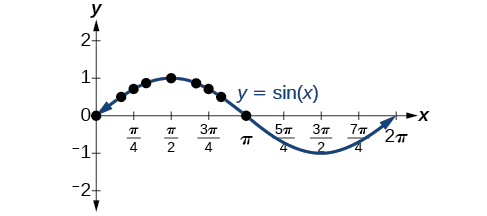
Notice how the sine values are positive between 0 and ![]() which correspond to the values of the sine function in quadrants I and II on the unit circle, and the sine values are negative between
which correspond to the values of the sine function in quadrants I and II on the unit circle, and the sine values are negative between ![]() and
and ![]() which correspond to the values of the sine function in quadrants III and IV on the unit circle. See (Figure 3).
which correspond to the values of the sine function in quadrants III and IV on the unit circle. See (Figure 3).

Now let’s take a similar look at the cosine function. Again, we can create a table of values and use them to sketch a graph. (Figure 4) lists some of the values for the cosine function on a unit circle.
As with the sine function, we can plots points to create a graph of the cosine function as in (Figure 4).

Because we can evaluate the sine and cosine of any real number, both of these functions are defined for all real numbers. By thinking of the sine and cosine values as coordinates of points on a unit circle, it becomes clear that the range of both functions must be the interval ![]()
In both graphs, the shape of the graph repeats after ![]() which means the functions are periodic with a period of
which means the functions are periodic with a period of ![]() A periodic function is a function for which a specific horizontal shift, P, results in a function equal to the original function:
A periodic function is a function for which a specific horizontal shift, P, results in a function equal to the original function: ![]() for all values of
for all values of ![]() in the domain of
in the domain of ![]() When this occurs, we call the smallest such horizontal shift with
When this occurs, we call the smallest such horizontal shift with ![]() the period of the function. (Figure 5) shows several periods of the sine and cosine functions.
the period of the function. (Figure 5) shows several periods of the sine and cosine functions.
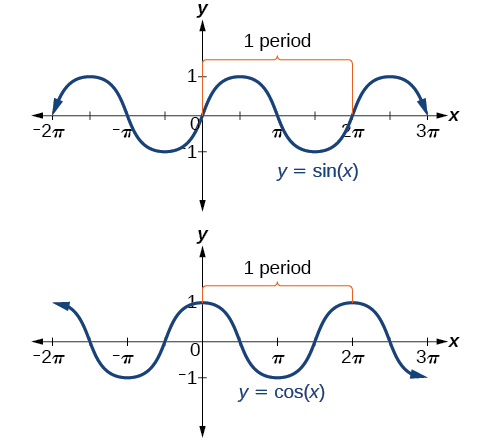
Looking again at the sine and cosine functions on a domain centered at the y-axis helps reveal symmetries. As we can see in (Figure 6), the sine function is symmetric about the origin. Recall from The Other Trigonometric Functions that we determined from the unit circle that the sine function is an odd function because ![]()
Now we can clearly see this property from the graph.
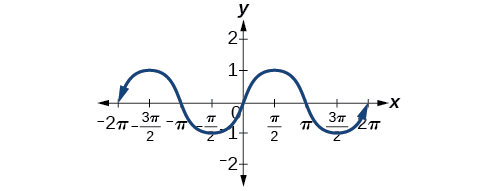
(Figure 7) shows that the cosine function is symmetric about the y-axis. Again, we determined that the cosine function is an even function. Now we can see from the graph that ![]()
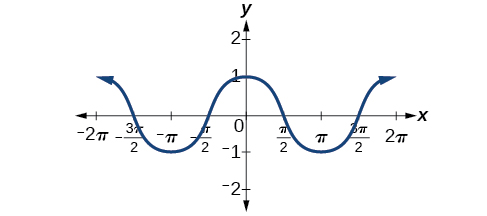
Characteristics of Sine and Cosine Functions
The sine and cosine functions have several distinct characteristics:
- They are periodic functions with a period of

- The domain of each function is
 and the range is
and the range is ![Rendered by QuickLaTeX.com \,\left[-1,1\right].](https://university.pressbooks.pub/app/uploads/quicklatex/quicklatex.com-910e5af71e23d02faf3e224d246587d1_l3.png)
- The graph of
 is symmetric about the origin, because it is an odd function.
is symmetric about the origin, because it is an odd function. - The graph of
 is symmetric about the
is symmetric about the  axis, because it is an even function.
axis, because it is an even function.
Investigating Sinusoidal Functions
As we can see, sine and cosine functions have a regular period and range. If we watch ocean waves or ripples on a pond, we will see that they resemble the sine or cosine functions. However, they are not necessarily identical. Some are taller or longer than others. A function that has the same general shape as a sine or cosine function is known as a sinusoidal function. The general forms of sinusoidal functions are

Determining the Period of Sinusoidal Functions
Looking at the forms of sinusoidal functions, we can see that they are transformations of the sine and cosine functions. We can use what we know about transformations to determine the period.
In the general formula, ![]() is related to the period by
is related to the period by ![]() If
If ![]() then the period is less than
then the period is less than ![]() and the function undergoes a horizontal compression, whereas if
and the function undergoes a horizontal compression, whereas if ![]() then the period is greater than
then the period is greater than ![]() and the function undergoes a horizontal stretch. For example,
and the function undergoes a horizontal stretch. For example, ![]() so the period is
so the period is ![]() which we knew. If
which we knew. If ![]() then
then ![]() so the period is
so the period is ![]() and the graph is compressed. If
and the graph is compressed. If ![]() then
then ![]() so the period is
so the period is ![]() and the graph is stretched. Notice in (Figure 8) how the period is indirectly related to
and the graph is stretched. Notice in (Figure 8) how the period is indirectly related to ![]()
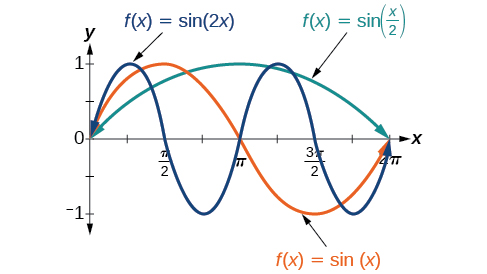
Period of Sinusoidal Functions
If we let ![]() and
and ![]() in the general form equations of the sine and cosine functions, we obtain the forms
in the general form equations of the sine and cosine functions, we obtain the forms
The period is ![]()
Identifying the Period of a Sine or Cosine Function
Determine the period of the function![]()
Show Solution
Let’s begin by comparing the equation to the general form![]()
In the given equation, ![]() so the period will be
so the period will be

Try It
Determine the period of the function ![]()
Show Solution
![]()
Determining Amplitude
Returning to the general formula for a sinusoidal function, we have analyzed how the variable ![]() relates to the period. Now let’s turn to the variable
relates to the period. Now let’s turn to the variable ![]() so we can analyze how it is related to the amplitude, or greatest distance from rest.
so we can analyze how it is related to the amplitude, or greatest distance from rest. ![]() represents the vertical stretch factor, and its absolute value
represents the vertical stretch factor, and its absolute value ![]() is the amplitude. The local maxima will be a distance
is the amplitude. The local maxima will be a distance ![]() above the horizontal midline of the graph, which is the line
above the horizontal midline of the graph, which is the line ![]() because
because ![]() in this case, the midline is the x-axis. The local minima will be the same distance below the midline. If
in this case, the midline is the x-axis. The local minima will be the same distance below the midline. If ![]() the function is stretched. For example, the amplitude of
the function is stretched. For example, the amplitude of ![]() is twice the amplitude of
is twice the amplitude of ![]() If
If ![]() the function is compressed. (Figure 9) compares several sine functions with different amplitudes.
the function is compressed. (Figure 9) compares several sine functions with different amplitudes.

Amplitude of Sinusoidal Functions
If we let ![]() and
and ![]() in the general form equations of the sine and cosine functions, we obtain the forms
in the general form equations of the sine and cosine functions, we obtain the forms
The amplitude is ![]() and the vertical height from the midline is
and the vertical height from the midline is ![]() In addition, notice in the example that
In addition, notice in the example that
Identifying the Amplitude of a Sine or Cosine Function
What is the amplitude of the sinusoidal function ![]() Is the function stretched or compressed vertically?
Is the function stretched or compressed vertically?
Show Solution
Let’s begin by comparing the function to the simplified form![]()
In the given function, ![]() so the amplitude is
so the amplitude is ![]() The function is stretched vertically.
The function is stretched vertically.
Analysis
The negative value of ![]() results in a reflection across the x-axis of the sine function, as shown in (Figure 10).
results in a reflection across the x-axis of the sine function, as shown in (Figure 10).
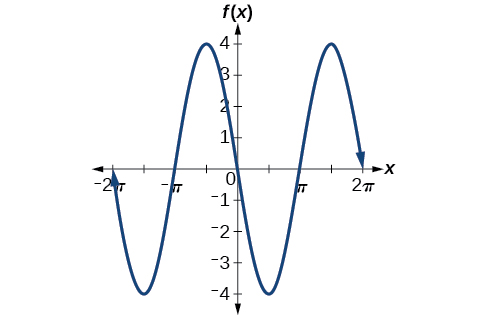
Try It
What is the amplitude of the sinusoidal function ![]() Is the function stretched or compressed vertically?
Is the function stretched or compressed vertically?
![]() compressed
compressed
Analyzing Graphs of Variations of y = sin x and y = cos x
Now that we understand how ![]() and
and ![]() relate to the general form equation for the sine and cosine functions, we will explore the variables
relate to the general form equation for the sine and cosine functions, we will explore the variables ![]() and
and ![]() Recall the general form:
Recall the general form:

The value ![]() for a sinusoidal function is called the phase shift, or the horizontal displacement of the basic sine or cosine function. If
for a sinusoidal function is called the phase shift, or the horizontal displacement of the basic sine or cosine function. If ![]() the graph shifts to the right. If
the graph shifts to the right. If ![]() the graph shifts to the left. The greater the value of
the graph shifts to the left. The greater the value of ![]() the more the graph is shifted. (Figure 11) shows that the graph of
the more the graph is shifted. (Figure 11) shows that the graph of ![]() shifts to the right by
shifts to the right by ![]() units, which is more than we see in the graph of
units, which is more than we see in the graph of ![]() which shifts to the right by
which shifts to the right by ![]() units.
units.
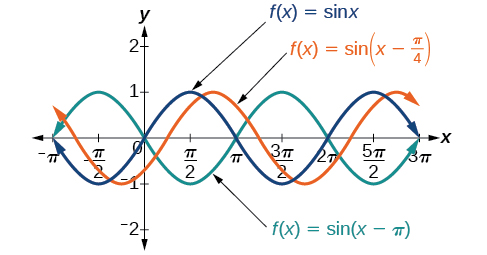
While![]() effects the horizontal shift,
effects the horizontal shift, ![]() indicates the vertical shift from the midline in the general formula for a sinusoidal function. See (Figure 12). The function
indicates the vertical shift from the midline in the general formula for a sinusoidal function. See (Figure 12). The function ![]() has its midline at
has its midline at ![]()
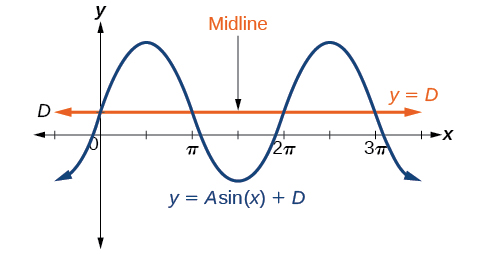
Any value of ![]() other than zero shifts the graph up or down. (Figure 13) compares
other than zero shifts the graph up or down. (Figure 13) compares ![]() with
with ![]() which is shifted 2 units up on a graph.
which is shifted 2 units up on a graph.
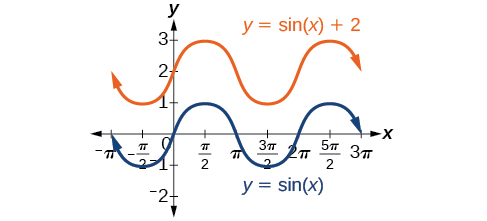
Variations of Sine and Cosine Functions
Given an equation in the form ![]() or
or ![]()
![]() is the phase shift and
is the phase shift and ![]() is the vertical shift.
is the vertical shift.
Identifying the Phase Shift of a Function
Determine the direction and magnitude of the phase shift for ![]()
Show Solution
Let’s begin by comparing the equation to the general form![]()
In the given equation, notice that ![]() and
and ![]() So the phase shift is
So the phase shift is
or ![]() units to the left.
units to the left.
Analysis
We must pay attention to the sign in the equation for the general form of a sinusoidal function. The equation shows a minus sign before ![]() Therefore
Therefore ![]() can be rewritten as
can be rewritten as ![]() If the value of
If the value of ![]() is negative, the shift is to the left.
is negative, the shift is to the left.
Try It
Determine the direction and magnitude of the phase shift for ![]()
Show Solution
![]() right
right
Identifying the Vertical Shift of a Function
Determine the direction and magnitude of the vertical shift for ![]()
Show Solution
Let’s begin by comparing the equation to the general form![]()
In the given equation, ![]() so the shift is 3 units downward.
so the shift is 3 units downward.
Try It
Determine the direction and magnitude of the vertical shift for ![]()
Show Solution
2 units up
Given a sinusoidal function in the form ![]() or
or ![]() identify the midline, amplitude, period, and phase shift.
identify the midline, amplitude, period, and phase shift.
- Determine the amplitude as

- Determine the period as

- Determine the phase shift as

- Determine the midline as

Identifying the Variations of a Sinusoidal Function from an Equation
Determine the midline, amplitude, period, and phase shift of the function ![]()
Show Solution
Let’s begin by comparing the equation to the general form ![]()
![]() so the amplitude is
so the amplitude is ![]()
Next, ![]() so the period is
so the period is ![]()
There is no added constant inside the parentheses, so ![]() and the phase shift is
and the phase shift is ![]()
Finally, ![]() so the midline is
so the midline is ![]()
Analysis
Inspecting the graph, we can determine that the period is ![]() the midline is
the midline is ![]() and the amplitude is 3. See (Figure 14).
and the amplitude is 3. See (Figure 14).
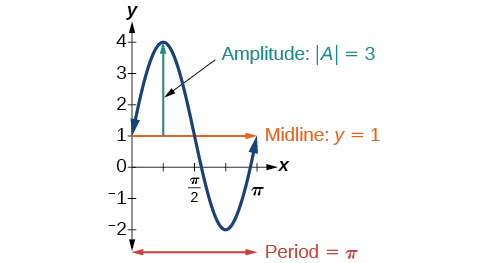
Try It
Determine the midline, amplitude, period, and phase shift of the function ![]()
Show Solution
midline: ![]() amplitude:
amplitude: ![]() period:
period: ![]() phase shift:
phase shift: ![]()
Identifying the Equation for a Sinusoidal Function from a Graph
Determine the formula for the cosine function in (Figure 15).
![A graph of -0.5cos(x)+0.5. The graph has an amplitude of 0.5. The graph has a period of 2pi. The graph has a range of [0, 1]. The graph is also reflected about the x-axis from the parent function cos(x).](https://s3-us-west-2.amazonaws.com/courses-images/wp-content/uploads/sites/3252/2018/07/19143157/CNX_Precalc_Figure_06_01_015.jpg)
Show Solution
To determine the equation, we need to identify each value in the general form of a sinusoidal function.
The graph could represent either a sine or a cosine function that is shifted and/or reflected. When ![]() the graph has an extreme point,
the graph has an extreme point,![]() Since the cosine function has an extreme point for
Since the cosine function has an extreme point for ![]() let us write our equation in terms of a cosine function.
let us write our equation in terms of a cosine function.
Let’s start with the midline. We can see that the graph rises and falls an equal distance above and below ![]() This value, which is the midline, is
This value, which is the midline, is ![]() in the equation, so
in the equation, so ![]() Note that this minimum is the reflection across the x-axis of cosine before the vertical shift.
Note that this minimum is the reflection across the x-axis of cosine before the vertical shift.
The greatest distance above and below the midline is the amplitude. The maxima are 0.5 units above the midline and the minima are 0.5 units below the midline. So ![]() Another way we could have determined the amplitude is by recognizing that the difference between the height of local maxima and minima is 1, so
Another way we could have determined the amplitude is by recognizing that the difference between the height of local maxima and minima is 1, so ![]() Also, the graph is reflected about the x-axis so that
Also, the graph is reflected about the x-axis so that ![]()
We can determine the period by measuring the distance between peaks. Since we have peaks at ![]() and
and ![]() the period is
the period is ![]()
The graph is not horizontally stretched or compressed, so ![]() and since cosine has an extreme point at x = 0, the graph is not shifted horizontally, so
and since cosine has an extreme point at x = 0, the graph is not shifted horizontally, so ![]()
Putting this all together,
Try It
Determine the formula for the sine function in (Figure 16).
![A graph of sin(x)+2. Period of 2pi, amplitude of 1, and range of [1, 3].](https://s3-us-west-2.amazonaws.com/courses-images/wp-content/uploads/sites/3252/2018/07/19143201/CNX_Precalc_Figure_06_01_016.jpg)
Show Solution
![]()
Identifying the Equation for a Sinusoidal Function from a Graph
Determine the equation for the sinusoidal function in (Figure 17).
![A graph of 3cos(pi/3x-pi/3)-2. Graph has amplitude of 3, period of 6, range of [-5,1].](https://s3-us-west-2.amazonaws.com/courses-images/wp-content/uploads/sites/3252/2018/07/19143204/CNX_Precalc_Figure_06_01_017.jpg)
Show Solution
With the highest value at 1 and the lowest value a t![]() the midline will be halfway between at
the midline will be halfway between at ![]() So
So ![]()
The distance from the midline to the highest or lowest value gives an amplitude of ![]()
The period of the graph is 6, which can be measured from the peak at ![]() to the next peak at
to the next peak at ![]() or from the distance between the lowest points. Therefore,
or from the distance between the lowest points. Therefore, ![]() Using the positive value for
Using the positive value for ![]() we find that
we find that
So far, our equation is either ![]() or
or![]() For the shape and shift, we have more than one option. We could write this as any one of the following:
For the shape and shift, we have more than one option. We could write this as any one of the following:
- a cosine shifted to the right
- a negative cosine shifted to the left
- a sine shifted to the left
- a negative sine shifted to the right
While any of these would be correct, the cosine shifts are easier to work with than the sine shifts in this case because they involve integer values. Since our phase shift is 1, and we have ![]() and
and ![]() then
then ![]() . So our function becomes
. So our function becomes
Again, these functions are equivalent, so both yield the same graph.
Try It
Write a formula for the function graphed in (Figure 18).
![A graph of 4sin((pi/5)x-pi/5)+4. Graph has period of 10, amplitude of 4, range of [0,8].](https://s3-us-west-2.amazonaws.com/courses-images/wp-content/uploads/sites/3252/2018/07/19143209/CNX_Precalc_Figure_06_01_018n.jpg)
Show Solution
two possibilities: ![]() or
or ![]()
Graphing Variations of y = sin x and y = cos x
Throughout this section, we have learned about types of variations of sine and cosine functions and used that information to write equations from graphs. Now we can use the same information to create graphs from equations.
Instead of focusing on the general form equations
we will let ![]() and
and ![]() and work with a simplified form of the equations in the following examples.
and work with a simplified form of the equations in the following examples.
Given the function![]() sketch its graph.
sketch its graph.
- Identify the amplitude,

- Identify the period,

- Start at the origin, with the function increasing to the right if
 is positive or decreasing if
is positive or decreasing if  is negative.
is negative. - At
 there is a local maximum for
there is a local maximum for  or a minimum for
or a minimum for with
with
- The curve returns to the x-axis at

- There is a local minimum for
 (maximum for
(maximum for  ) at
) at  with
with
- The curve returns again to the x-axis at

Given the function![]() sketch its graph.
sketch its graph.
- Identify the amplitude,

- Identify the period,

- Start on the y axis with the point
 , with the function decreasing to the right if
, with the function decreasing to the right if  is positive or increasing if
is positive or increasing if  is negative.
is negative. - At
 there is a local minimum for
there is a local minimum for  or a mamimum for
or a mamimum for  with
with 
- There are x axis intercepts at
 and
and  .
. - The curve completes the period at

Graphing a Function and Identifying the Amplitude and Period
Sketch a graph of ![]()
Show Solution
Let’s begin by comparing the equation to the form ![]()
- Step 1. We can see from the equation that
 so the amplitude is 2.
so the amplitude is 2.

- Step 2. The equation shows that
 so the period is
so the period is

- Step 3. Because
 is negative, the graph descends as we move to the right of the origin.
is negative, the graph descends as we move to the right of the origin. - Step 4–7. The x-intercepts are at the beginning of one period,
 the horizontal midpoints are at
the horizontal midpoints are at  and at the end of one period at
and at the end of one period at 
The quarter points include the minimum at ![]() and the maximum at
and the maximum at ![]() A local minimum will occur 2 units below the midline, at
A local minimum will occur 2 units below the midline, at ![]() and a local maximum will occur at 2 units above the midline, at
and a local maximum will occur at 2 units above the midline, at ![]() (Figure 19) shows the graph of the function.
(Figure 19) shows the graph of the function.
![A graph of -2sin((pi/2)x). Graph has range of [-2,2], period of 4, and amplitude of 2.](https://s3-us-west-2.amazonaws.com/courses-images/wp-content/uploads/sites/3252/2018/07/19143217/CNX_Precalc_Figure_06_01_019.jpg)
Try It
Sketch a graph of ![]() Determine the midline, amplitude, period, and phase shift.
Determine the midline, amplitude, period, and phase shift.
Show Solution
![A graph of -0.8cos(2x). Graph has range of [-0.8, 0.8], period of pi, amplitude of 0.8, and is reflected about the x-axis compared to it's parent function cos(x).](https://s3-us-west-2.amazonaws.com/courses-images/wp-content/uploads/sites/3252/2018/07/19143231/CNX_Precalc_Figure_06_01_020.jpg)
midline: ![]() amplitude:
amplitude: ![]() period:
period: ![]() phase shift:
phase shift: ![]() or none
or none
Given a sinusoidal function with a phase shift and a vertical shift, sketch its graph.
- Express the function in the general form

- Identify the amplitude,

- Identify the period,

- Identify the phase shift,

- Draw the graph of
 shifted to the right or left by
shifted to the right or left by  and up or down by
and up or down by 
Graphing a Transformed Sinusoid
Sketch a graph of ![]()
Show Solution
- Step 1. The function is already written in general form:
 This graph will have the shape of a sine function, starting at the midline and increasing to the right.
This graph will have the shape of a sine function, starting at the midline and increasing to the right. - Step 2.
 The amplitude is 3.
The amplitude is 3. - Step 3. Since
 we determine the period as follows.
we determine the period as follows.

The period is 8.
- Step 4. Since
 the phase shift is
the phase shift is

The phase shift is 1 unit.
- Step 5.(Figure 20) shows the graph of the function.

Figure 20. A horizontally compressed, vertically stretched, and horizontally shifted sinusoid
Try It
Draw a graph of ![]() Determine the midline, amplitude, period, and phase shift.
Determine the midline, amplitude, period, and phase shift.
Show Solution

midline: ![]() amplitude:
amplitude: ![]() period:
period: ![]() phase shift:
phase shift: ![]()
Identifying the Properties of a Sinusoidal Function
Given ![]() determine the amplitude, period, phase shift, and horizontal shift. Then graph the function.
determine the amplitude, period, phase shift, and horizontal shift. Then graph the function.
Show Solution
Begin by comparing the equation to the general form and use the steps outlined in (Figure 21).
- Step 1. The function is already written in general form.
- Step 2. Since
 the amplitude is
the amplitude is 
- Step 3.
 so the period is
so the period is  The period is 4.
The period is 4. - Step 4.
 so we calculate the phase shift as
so we calculate the phase shift as  The phase shift is
The phase shift is 
- Step 5.
 so the midline is
so the midline is  and the vertical shift is up 3.
and the vertical shift is up 3.
Since ![]() is negative, the graph of the cosine function has been reflected about the x-axis.
is negative, the graph of the cosine function has been reflected about the x-axis.
(Figure 21) shows one cycle of the graph of the function.
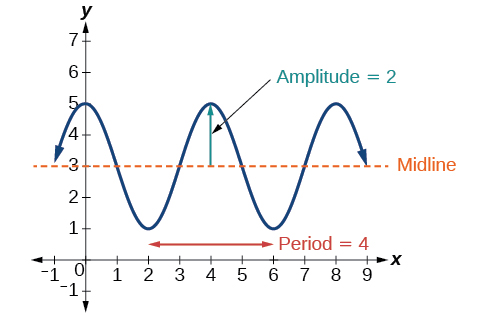
Using Transformations of Sine and Cosine Functions
We can use the transformations of sine and cosine functions in numerous applications. As mentioned at the beginning of the chapter, circular motion can be modeled using either the sine or cosine function.
Finding the Vertical Component of Circular Motion
A point rotates around a circle of radius 3 centered at the origin. Sketch a graph of the y-coordinate of the point as a function of the angle of rotation.
Show Solution
Recall that, for a point on a circle of radius r, the y-coordinate of the point is ![]()
so in this case, we get the equation ![]()
The constant 3 causes a vertical stretch of the y-values of the function by a factor of 3, which we can see in the graph in (Figure 22).
![A graph of 3sin(x). Graph has period of 2pi, amplitude of 3, and range of [-3,3].](https://s3-us-west-2.amazonaws.com/courses-images/wp-content/uploads/sites/3252/2018/07/19143251/CNX_Precalc_Figure_06_01_023.jpg)
Analysis
Notice that the period of the function is still ![]() as we travel around the circle, we return to the point
as we travel around the circle, we return to the point ![]() for
for ![]() Because the outputs of the graph will now oscillate between
Because the outputs of the graph will now oscillate between ![]() and
and ![]() the amplitude of the sine wave is
the amplitude of the sine wave is ![]()
Try It
What is the amplitude of the function ![]() Sketch a graph of this function.
Sketch a graph of this function.
Show Solution
7
![A graph of 7cos(x). Graph has amplitude of 7, period of 2 pi, and range of [-7,7].](https://s3-us-west-2.amazonaws.com/courses-images/wp-content/uploads/sites/3252/2018/07/19143253/CNX_Precalc_Figure_06_01_024.jpg)
Finding the Vertical Component of Circular Motion
A circle with radius 3 ft is mounted with its center 4 ft off the ground. The point closest to the ground is labeled P, as shown in (Figure 23). Sketch a graph of the height above the ground of the point ![]() as the circle is rotated; then find a function that gives the height in terms of the angle of rotation.
as the circle is rotated; then find a function that gives the height in terms of the angle of rotation.
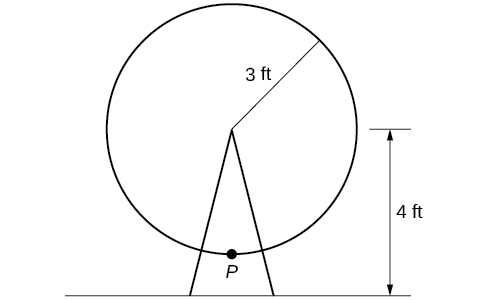
Show Solution
Sketching the height, we note that it will start 1 ft above the ground, then increase up to 7 ft above the ground, and continue to oscillate 3 ft above and below the center value of 4 ft, as shown in (Figure 24).
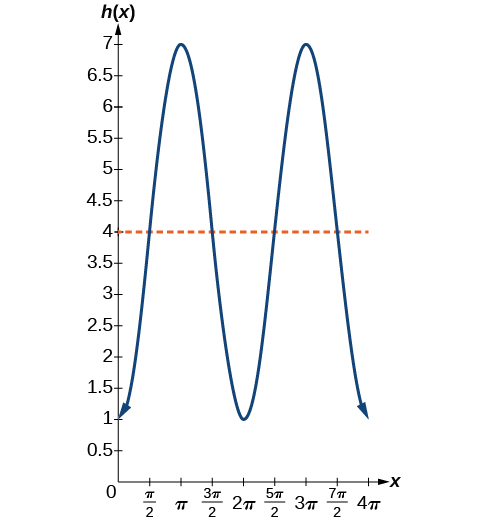
Although we could use a transformation of either the sine or cosine function, we start by looking for characteristics that would make one function easier to use than the other. Let’s use a cosine function because it starts at the highest or lowest value, while a sine function starts at the middle value. A standard cosine starts at the highest value, and this graph starts at the lowest value, so we need to incorporate a vertical reflection.
Second, we see that the graph oscillates 3 ft above and below the center, while a basic cosine has an amplitude of 1 ft, so this graph has been vertically stretched by 3, as in the last example.
Finally, to move the center of the circle up to a height of 4 ft, the graph has been vertically shifted up by 4 ft. Putting these transformations together, we find that
Try It
A weight is attached to a spring that is then hung from a board, as shown in (Figure 25). As the spring oscillates up and down, the position ![]() of the weight relative to the board ranges from
of the weight relative to the board ranges from ![]() in. (at time
in. (at time ![]() to
to ![]() in. (at time
in. (at time ![]() below the board. Assume the position of
below the board. Assume the position of ![]() is given as a sinusoidal function of
is given as a sinusoidal function of ![]() Sketch a graph of the function, and then find a cosine function that gives the position
Sketch a graph of the function, and then find a cosine function that gives the position ![]() in terms of
in terms of ![]()
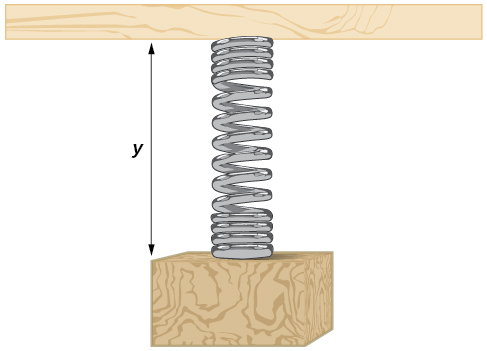
Show Solution
![]()
![A cosine graph with range [-1,-7]. Period is 2 pi. Local maximums at (0,-1), (2pi,-1), and (4pi, -1). Local minimums at (pi,-7) and (3pi, -7).](https://s3-us-west-2.amazonaws.com/courses-images/wp-content/uploads/sites/3252/2018/07/19143331/CNX_Precalc_Figure_06_01_027.jpg)
Determining a Rider’s Height on a Ferris Wheel
The London Eye is a huge Ferris wheel with a diameter of 135 meters (443 feet). It completes one rotation every 30 minutes. Riders board from a platform 2 meters above the ground. Express a rider’s height above ground as a function of time in minutes.
Show Solution
With a diameter of 135 m, the wheel has a radius of 67.5 m. The height will oscillate with amplitude 67.5 m above and below the center.
Passengers board 2 m above ground level, so the center of the wheel must be located ![]() m above ground level. The midline of the oscillation will be at 69.5 m.
m above ground level. The midline of the oscillation will be at 69.5 m.
The wheel takes 30 minutes to complete 1 revolution, so the height will oscillate with a period of 30 minutes.
Lastly, because the rider boards at the lowest point, the height will start at the smallest value and increase, following the shape of a vertically reflected cosine curve.
- Amplitude:
 so
so 
- Midline:
 so
so 
- Period:
 so
so 
- Shape:

An equation for the rider’s height would be
where ![]() is in minutes and
is in minutes and ![]() is measured in meters.
is measured in meters.
Access these online resources for additional instruction and practice with graphs of sine and cosine functions.
Key Equations
| Sinusoidal functions |
Key Concepts
- Periodic functions repeat after a given value. The smallest such value is the period. The basic sine and cosine functions have a period of

- The function
 is odd, so its graph is symmetric about the origin. The function
is odd, so its graph is symmetric about the origin. The function  is even, so its graph is symmetric about the y-axis.
is even, so its graph is symmetric about the y-axis. - The graph of a sinusoidal function has the same general shape as a sine or cosine function.
- In the general formula for a sinusoidal function, the period is
 See (Figure).
See (Figure). - In the general formula for a sinusoidal function,
 represents amplitude. If
represents amplitude. If  the function is stretched, whereas if
the function is stretched, whereas if  the function is compressed. See (Figure).
the function is compressed. See (Figure). - The value
 in the general formula for a sinusoidal function indicates the phase shift. See (Figure).
in the general formula for a sinusoidal function indicates the phase shift. See (Figure). - The value
 in the general formula for a sinusoidal function indicates the vertical shift from the midline. See (Figure).
in the general formula for a sinusoidal function indicates the vertical shift from the midline. See (Figure). - Combinations of variations of sinusoidal functions can be detected from an equation. See (Figure).
- The equation for a sinusoidal function can be determined from a graph. See (Figure) and (Figure).
- A function can be graphed by identifying its amplitude and period. See (Figure) and (Figure).
- A function can also be graphed by identifying its amplitude, period, phase shift, and horizontal shift. See (Figure).
- Sinusoidal functions can be used to solve real-world problems. See (Figure), (Figure), and (Figure).
Section Exercises
Verbal
Why are the sine and cosine functions called periodic functions?
Show Solution
The sine and cosine functions have the property that![]() for a certain
for a certain ![]() This means that the function values repeat for every
This means that the function values repeat for every ![]() units on the x-axis.
units on the x-axis.
How does the graph of ![]()
compare with the graph of ![]()
Explain how you could horizontally translate the graph of ![]()
to obtain ![]()
For the equation ![]() what constants affect the range of the function and how do they affect the range?
what constants affect the range of the function and how do they affect the range?
Show Solution
The absolute value of the constant ![]() (amplitude) increases the total range and the constant
(amplitude) increases the total range and the constant ![]() (vertical shift) shifts the graph vertically.
(vertical shift) shifts the graph vertically.
How does the range of a translated sine function relate to the equation ![]()
How can the unit circle be used to construct the graph of ![]()
Show Solution
At the point where the terminal side of ![]() intersects the unit circle, you can determine that the
intersects the unit circle, you can determine that the ![]() equals the y-coordinate of the point.
equals the y-coordinate of the point.
Graphical
For the following exercises, graph two full periods of each function and state the amplitude, period, and midline. State the maximum and minimum y-values and their corresponding x-values on one period for ![]() Round answers to two decimal places if necessary.
Round answers to two decimal places if necessary.
![]()
![]()
Show Solution
![A graph of (2/3)cos(x). Graph has amplitude of 2/3, period of 2pi, and range of [-2/3, 2/3].](https://s3-us-west-2.amazonaws.com/courses-images/wp-content/uploads/sites/3252/2018/07/19143339/CNX_Precalc_Figure_06_01_202.jpg)
amplitude: ![]() period:
period: ![]() midline:
midline: ![]() maximum:
maximum: ![]() occurs at
occurs at ![]() minimum:
minimum: ![]() occurs at
occurs at ![]() for one period, the graph starts at 0 and ends at
for one period, the graph starts at 0 and ends at ![]()
![]()
![]()
Show Solution
![A graph of 4sin(x). Graph has amplitude of 4, period of 2pi, and range of [-4, 4].](https://s3-us-west-2.amazonaws.com/courses-images/wp-content/uploads/sites/3252/2018/07/19143349/CNX_Precalc_Figure_06_01_204.jpg)
amplitude: 4; period: ![]() midline:
midline: ![]() maximum
maximum ![]() occurs at
occurs at ![]() minimum:
minimum: ![]() occurs at
occurs at ![]() one full period occurs from
one full period occurs from ![]() to
to ![]()
![]()
![]()
Show Solution
![A graph of cos(2x). Graph has amplitude of 1, period of pi, and range of [-1,1].](https://s3-us-west-2.amazonaws.com/courses-images/wp-content/uploads/sites/3252/2018/07/19143352/CNX_Precalc_Figure_06_01_206.jpg)
amplitude: 1; period: ![]() midline:
midline: ![]() maximum:
maximum: ![]() occurs at
occurs at ![]() minimum:
minimum: ![]() occurs at
occurs at ![]() one full period is graphed from
one full period is graphed from ![]() to
to ![]()
![]()
![]()
Show Solution
![A graph of 4cos(pi*x). Grpah has amplitude of 4, period of 2, and range of [-4, 4].](https://s3-us-west-2.amazonaws.com/courses-images/wp-content/uploads/sites/3252/2018/07/19143354/CNX_Precalc_Figure_06_01_208.jpg)
amplitude: 4; period: 2; midline: ![]() maximum:
maximum: ![]() occurs at
occurs at ![]() minimum:
minimum: ![]() occurs at
occurs at ![]()
![]()
![]()
Show Solution
![A graph of 3sin(8(x+4))+5. Graph has amplitude of 3, range of [2, 8], and period of pi/4.](https://s3-us-west-2.amazonaws.com/courses-images/wp-content/uploads/sites/3252/2018/07/19143401/CNX_Precalc_Figure_06_01_210.jpg)
amplitude: 3; period: ![]() midline:
midline: ![]() maximum:
maximum: ![]() occurs at
occurs at ![]() minimum:
minimum:![]() occurs at
occurs at ![]() horizontal shift:
horizontal shift: ![]() vertical translation 5; one period occurs from
vertical translation 5; one period occurs from ![]() to
to ![]()
![]()
![]()
Show Solution
![A graph of 5sin(5x+20)-2. Graph has an amplitude of 5, period of 2pi/5, and range of [-7,3].](https://s3-us-west-2.amazonaws.com/courses-images/wp-content/uploads/sites/3252/2018/07/19143404/CNX_Precalc_Figure_06_01_212.jpg)
amplitude: 5; period: ![]() midline:
midline: ![]() maximum:
maximum: ![]() occurs at
occurs at ![]() minimum:
minimum:![]() occurs at
occurs at ![]() phase shift:
phase shift: ![]() vertical translation:
vertical translation: ![]() one full period can be graphed on
one full period can be graphed on ![]() to
to ![]()
For the following exercises, graph one full period of each function, starting at ![]() For each function, state the amplitude, period, and midline. State the maximum and minimum y-values and their corresponding x-values on one period for
For each function, state the amplitude, period, and midline. State the maximum and minimum y-values and their corresponding x-values on one period for ![]() State the phase shift and vertical translation, if applicable. Round answers to two decimal places if necessary.
State the phase shift and vertical translation, if applicable. Round answers to two decimal places if necessary.
![]()
![]()
Show Solution
![A graph of -cos(t+pi/3)+1. Graph has amplitude of 1, period of 2pi, and range of [0,2]. Phase shifted pi/3 to the left.](https://s3-us-west-2.amazonaws.com/courses-images/wp-content/uploads/sites/3252/2018/07/19143411/CNX_Precalc_Figure_06_01_214.jpg)
amplitude: 1 ; period: ![]() midline:
midline: ![]() maximum:
maximum: ![]() occurs at
occurs at ![]() maximum:
maximum: ![]() occurs at
occurs at ![]() minimum:
minimum: ![]() occurs at
occurs at ![]() phase shift:
phase shift: ![]() vertical translation: 1; one full period is from
vertical translation: 1; one full period is from ![]() to
to ![]()
![]()
![]()
Show Solution
![A graph of -sin((1/2)*t + 5pi/3). Graph has amplitude of 1, range of [-1,1], period of 4pi, and a phase shift of -10pi/3.](https://s3-us-west-2.amazonaws.com/courses-images/wp-content/uploads/sites/3252/2018/07/19143419/CNX_Precalc_Figure_06_01_216.jpg) amplitude: 1; period:
amplitude: 1; period: ![]() midline:
midline: ![]() maximum:
maximum: ![]() occurs at
occurs at ![]() minimum:
minimum: ![]() occurs at
occurs at ![]() phase shift:
phase shift: ![]() vertical shift: 0
vertical shift: 0
![]()
Determine the amplitude, midline, period, and an equation involving the sine function for the graph shown in (Figure 26).
![A sinusoidal graph with amplitude of 2, range of [-5, -1], period of 4, and midline at y=-3.](https://s3-us-west-2.amazonaws.com/courses-images/wp-content/uploads/sites/3252/2018/07/19143443/CNX_Precalc_Figure_06_01_218.jpg)
Show Solution
amplitude: 2; midline: ![]() period: 4; equation:
period: 4; equation: ![]()
Determine the amplitude, period, midline, and an equation involving cosine for the graph shown in (Figure 27).
![A graph with a cosine parent function, with amplitude of 3, period of pi, midline at y=-1, and range of [-4,2]](https://s3-us-west-2.amazonaws.com/courses-images/wp-content/uploads/sites/3252/2018/07/19143449/CNX_Precalc_Figure_06_01_219.jpg)
Determine the amplitude, period, midline, and an equation involving cosine for the graph shown in (Figure 28).
![A graph with a cosine parent function with an amplitude of 2, period of 5, midline at y=3, and a range of [1,5].](https://s3-us-west-2.amazonaws.com/courses-images/wp-content/uploads/sites/3252/2018/07/19143502/CNX_Precalc_Figure_06_01_220.jpg)
Show Solution
amplitude: 2; period: 5; midline: ![]() equation:
equation: ![]()
Determine the amplitude, period, midline, and an equation involving sine for the graph shown in (Figure 29).
![A sinusoidal graph with amplitude of 4, period of 10, midline at y=0, and range [-4,4].](https://s3-us-west-2.amazonaws.com/courses-images/wp-content/uploads/sites/3252/2018/07/19143505/CNX_Precalc_Figure_06_01_221.jpg)
Determine the amplitude, period, midline, and an equation involving cosine for the graph shown in (Figure 30).
![A graph with cosine parent function, range of function is [-4,4], amplitude of 4, period of 2.](https://s3-us-west-2.amazonaws.com/courses-images/wp-content/uploads/sites/3252/2018/07/19143516/CNX_Precalc_Figure_06_01_222.jpg)
Show Solution
amplitude: 4; period: 2; midline: ![]() equation:
equation: ![]()
Determine the amplitude, period, midline, and an equation involving sine for the graph shown in (Figure 31).
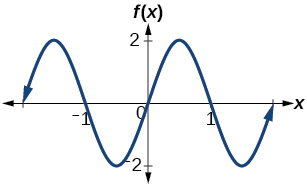
Determine the amplitude, period, midline, and an equation involving cosine for the graph shown in (Figure 32).
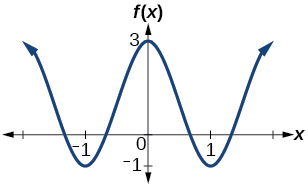
Show Solution
amplitude: 2; period: 2; midline ![]() equation:
equation: ![]()
Determine the amplitude, period, midline, and an equation involving sine for the graph shown in (Figure 33).
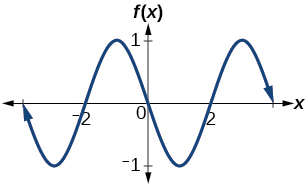
Algebraic
For the following exercises, let ![]()
On ![]() solve
solve![]()
On ![]() solve
solve![]()
Show Solution
![]()
Evaluate ![]()
On ![]() Find all values of
Find all values of ![]()
Show Solution
![]()
On ![]() the maximum value(s) of the function occur(s) at what x-value(s)?
the maximum value(s) of the function occur(s) at what x-value(s)?
On ![]() the minimum value(s) of the function occur(s) at what x-value(s)?
the minimum value(s) of the function occur(s) at what x-value(s)?
Show Solution
![]()
Show that ![]() This means that
This means that ![]() is an odd function and possesses symmetry with respect to ________________.
is an odd function and possesses symmetry with respect to ________________.
For the following exercises, let ![]()
On ![]() solve the equation
solve the equation ![]()
Show Solution
![]()
On ![]() solve
solve ![]()
On ![]() find the x-intercepts of
find the x-intercepts of ![]()
Show Solution
![]()
On ![]() find the x-values at which the function has a maximum or minimum value.
find the x-values at which the function has a maximum or minimum value.
On ![]() solve the equation
solve the equation![]()
Show Solution
![]()
Technology
Graph ![]() on
on ![]() Explain why the graph appears as it does.
Explain why the graph appears as it does.
Graph ![]() on
on ![]() Did the graph appear as predicted in the previous exercise?
Did the graph appear as predicted in the previous exercise?
Show Solution
The graph appears linear. The linear functions dominate the shape of the graph for large values of ![]()

Graph ![]() on
on ![]() and verbalize how the graph varies from the graph of
and verbalize how the graph varies from the graph of ![]()
Graph ![]() on the window
on the window ![]() and explain what the graph shows.
and explain what the graph shows.
Show Solution
The graph is symmetric with respect to the y-axis and there is no amplitude because the function is not periodic.

Graph ![]() on the window
on the window ![]() and explain what the graph shows.
and explain what the graph shows.
Real-World Applications
A Ferris wheel is 25 meters in diameter and boarded from a platform that is 1 meter above the ground. The six o’clock position on the Ferris wheel is level with the loading platform. The wheel completes 1 full revolution in 10 minutes. The function ![]() gives a person’s height in meters above the ground t minutes after the wheel begins to turn.
gives a person’s height in meters above the ground t minutes after the wheel begins to turn.
- Find the amplitude, midline, and period of

- Find a formula for the height function

- How high off the ground is a person after 5 minutes?
Show Solution
- Amplitude: 12.5; period: 10; midline:


- 26 ft
Glossary
- amplitude
- the vertical height of a function; the constant
 appearing in the definition of a sinusoidal function
appearing in the definition of a sinusoidal function
- midline
- the horizontal line
 where
where  appears in the general form of a sinusoidal function
appears in the general form of a sinusoidal function
- periodic function
- a function
 that satisfies
that satisfies  for a specific constant
for a specific constant  and any value of
and any value of 
- phase shift
- the horizontal displacement of the basic sine or cosine function; the constant

- sinusoidal function
- any function that can be expressed in the form
 or
or 
